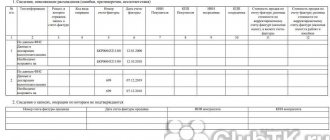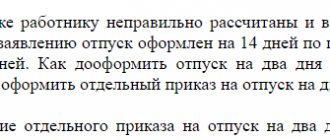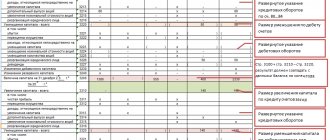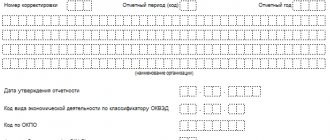News
Digest date: 02/17/2012.
During the preparation of financial statements, the accountant traditionally asks the questions: is everything in order in the documents, are there any errors in accounting and reporting, what criteria should they be included in and how to correct them? Answers to all these questions can be found in PBU 22/2010. You should not neglect this document, because errors in accounting entail errors in tax accounting. But reading the text of PBU 22/2010 can sometimes be difficult and unclear. There is not always enough time to search for various comments on this topic. But having a compact cheat sheet on hand, which contains advice on this issue, as well as expert opinions, and articles that allow you to understand the intricate labyrinths of the law, is just a godsend for an accountant. This will be discussed in our publication. According to Clause 2 of PBU 22/2010 “Correcting errors in accounting and reporting” approved. Order of the Ministry of Finance of the Russian Federation dated June 28, 2010 N 63n states: “An error in accounting and reporting is an incorrect reflection or non-reflection of the facts of economic activity in the accounting and (or) financial statements of an organization.” 1. The causes of errors may be the following:
- incorrect application of the legislation of the Russian Federation on accounting and (or) regulatory legal acts on accounting;
- incorrect application of the organization's accounting policies;
- inaccuracies in calculations;
- incorrect classification or assessment of facts of economic activity;
- incorrect use of information available at the date of signing the financial statements;
- dishonest actions of officials of the organization.
2. Methods for identifying errors 2.1. Inventory of the organization's property . With its help, errors of the reporting year, shortages, thefts, as well as errors associated with documenting transactions are most easily identified. 2.2. Reconciliation of settlements with counterparties. Reconciliation with debtors and creditors is carried out at least once a quarter, but preferably monthly. This method is used to detect missing documents, errors in them, and write off overdue debts. 2.3. Analysis of the “Chess” sheet and identification of “non-standard” entries or errors in the correspondence of accounts. 2.4. Method of arithmetic-logical control. There are certain “control points” in reporting, the values of which must match in properly prepared financial statements. Checking them allows you to independently identify errors. 3. Methods for correcting errors According to paragraph 5 of Art. 9 of Law No. 129-FZ, corrections to primary accounting documents can only be made in agreement with participants in business transactions, which must be confirmed by the signatures of the same persons who signed the documents, indicating the date of the corrections. It is prohibited to make corrections to cash and bank documents. To correct erroneous entries in primary accounting documents and accounting registers, three classical methods are used. 3.1. The correct method is as follows. Any mistake made should be crossed out with one line (so that the incorrect entry can be read) and the correct text or amount written on top. Then the correct text or amount is repeated in the margins of the document or at the bottom and certified by the signature of the person who made the correction, in agreement with the participants in the business transaction and indicating the date the correction was made. 3.2. The additional posting method is used in cases where the accounting entry or accounting registers indicate a transaction amount that is less than the actual amount. To correct such an error, additional accounting entries are made for the difference between the correct and underestimated transaction amounts. 3.3. The “red reversal” method is used when incorrect correspondence of accounts is indicated in the accounting records. In this case, the incorrect old entry is canceled by repeating it in red and a new correct entry is made, but in ordinary ink. In practice, there are three types of errors that must be corrected by reversal. 3.3.1. The accounting entries and account entries were made unreasonably, since the business transaction did not take place. Such an error can be corrected with one “red” posting and an entry in the accounting registers, which will “extinguish” the incorrect entries. 3.3.2. Accounting entries and account entries are made on the basis of the primary document and correspond to the amount of transactions. The amount was mistakenly credited to the wrong account. To correct this, two entries are made. In the first posting, incorrect correspondence is repeated in red. The second entry shows the correct correspondence. 3.3.3. When the posting is made correctly, but the transaction amount is overstated. In these cases, a note is made in red ink to indicate the amount of the overstatement. 4. Classification of errors in accounting and reporting 4.1. By level of materiality Methods for reflecting an error in accounting depend on whether it is considered significant. According to the level of materiality, PBU 22/2010 divided errors into significant and insignificant. 4.1.1. An error is considered significant if it, individually or in combination with other errors for the same reporting period, can affect the economic decisions of users made on the basis of the financial statements compiled for this reporting period. The organization determines the materiality of the error independently, based on both the size and nature of the relevant article (articles) of the financial statements (clause 3 of PBU 22/2010). Materiality criteria must be enshrined in the accounting policies of the organization. 4.1.2. An error is considered insignificant if it does not meet the materiality criteria established by the organization 4.2. Based on the period of occurrence, significant and insignificant errors can be classified: errors of the reporting year; errors of the previous reporting year. 4.3. Based on the error detection period, the classification is a little more complicated. Here you need to consider:
- materiality,
- period of occurrence,
- procedure for approving annual financial statements.
Errors in the reporting year are identified and corrected in two cases: before the end of the reporting year, i.e. until December 31, and after the end of the reporting year, but before the date of signing the statements. Errors of the previous reporting year are classified according to the following types and periods of detection:
- An insignificant error identified after the date of signing the financial statements;
- A significant error identified after the date of signing the financial statements, but before the date of presentation of such statements, i.e. until March 31 of the year following the reporting year;
- A significant error identified after the presentation of financial statements. Such a period for an OJSC is the period from March 31 to June 30 of the year following the reporting year. For LLC - from March 31 to April 30 of the year following the reporting year;
- A significant error identified after approval of the financial statements. For an OJSC, this period will be the period after June 30 of the year following the reporting year. For LLCs - after April 30 of the year following the reporting year.
- A significant error was made before the beginning of the earliest previous reporting period presented in the financial statements for the current reporting year.
The current reporting year is currently 2011. The earliest date on the balance sheet is December 31, 2009. This means that it will be necessary to consider significant mistakes made before 2009. If the current reporting year is 2012, then the earliest date will be the period before 2010. 4.4. According to the nature of the commission , errors can be divided into intentional and unintentional. 4.4.1. Unintentional errors can be caused by: Incorrect application of the organization's accounting policies. Inaccuracies in calculations.; Incorrect classification or assessment of facts of economic activity. For example, incomplete determination of costs when forming the initial cost of a fixed asset item. Incorrect use of information available at the date of signing the financial statements. For example, untimely transfer to the accounting department of documents received at the enterprise’s warehouse; Incorrect application of the legislation of the Russian Federation on accounting and (or) regulatory legal acts on accounting. For example, errors caused by non-compliance with PBU 6/01: incorrect inclusion of fixed assets in the group of industrial inventories. 4.4.2. Intentional errors are made in cases of dishonest actions by officials of the organization: forgery, falsification of documents, concealment of accounting data, deliberate forgery of documents on the release of materials into production, carried out in order to conceal the fact of theft. 4.5. Errors by content are divided into: 4.5.1. Errors in documenting operations - reflecting an operation in the absence of primary documents or, conversely, the presence of falsified documents for operations that were not performed. Errors in the period of reflection, when a business transaction carried out in one reporting period is reflected in accounting and reporting in the next period. Most often they arise due to late receipt of accompanying documents from counterparties - invoices, invoices, etc.; Errors in the correspondence of accounts, expressed in the preparation of incorrect entries that distort the economic essence of the transactions performed. Errors in valuation associated with violation of established rules for determining the initial and actual cost of accounting objects, calculating depreciation, etc. Errors in the presentation of information in reporting. For example, the balance of settlement accounts is “collapsed” 60,62,76,71. 4.5.2. Specific errors arise when using incorrectly configured accounting computer programs, as well as due to computer failures. For example, data entered into a computer may be lost due to computer viruses, sudden power outages, etc. 4.6. Inaccuracies or omissions in the reflection of facts of economic activity in the accounting and (or) financial statements of an organization identified as a result of obtaining new information that was not available to the organization at the time of reflection (non-reflection) of such facts of economic activity are not considered errors. 5. The procedure for correcting errors According to clause 4 of PBU 22/2010, all identified errors and their consequences are subject to mandatory correction. The procedure for correcting errors is established by section 2 of PBU 22/2010. Accounting errors of the current year and previous years are now corrected depending on two criteria: materiality and period of discovery. 5.1. Period during which corrections are made: 5.1.1. Month of the reporting year in which the error was detected Error in the reporting year identified before December 31 of this year. Corrections are made by entries in the relevant accounting accounts in the month of the reporting year in which the error was identified. 5.1.2. December 31 of the reporting year: A reporting year error detected after December 31 of the reporting year, but before the date of signing the financial statements for that year. A significant error of the previous reporting year, identified after the date of signing the financial statements for this year, but before March 31. A significant error in the previous reporting year that was discovered after the financial statements for that year were presented to shareholders. From March 31 to April 30 (for an LLC). From March 31 to June 30 (for an OJSC) In this case, revised financial statements are drawn up, which disclose information that these financial statements replace the originally presented financial statements, as well as the grounds for drawing up the revised accounting statements. The revised financial statements are submitted to all addresses to which the original financial statements were submitted. 5.1.3. Current reporting period: A significant error of the previous reporting year, identified after the approval of the financial statements for this year. After April 30 (for LLC). After June 30 (for JSC). 5.1.4. Features of correction of errors by small businesses Small businesses, with the exception of issuers of publicly placed securities, make corrective entries on the relevant accounts in the month of discovery in correspondence with account 91 without retrospective recalculation of statements. 5.2. Procedure for making corrections 5.2.1. If the distortion relates to the current period , then it is corrected in the month in which it was discovered. In this case, the correction of the error is taken into account when preparing the financial statements for the current year. Example. The fixed asset used by the company's management has not been registered. No depreciation has been accrued on fixed assets. The error was made in December 2011. The accountant makes the following entries in December: Debit 08 “Investments in non-current assets” Credit 60 “Settlements with suppliers and contractors” - the purchase price of the object is reflected; Debit 01 “Fixed assets” Credit 08 “Investments in non-current assets” - the object is accepted for accounting; Debit 26 “General business expenses” Credit 02 “Depreciation of fixed assets” - reflects the amount of depreciation charges for general plant service facilities; Debit 90 “Sales” Credit 26 “General expenses” - administrative expenses are written off. 5.2.2. If an error was made in the previous reporting period, but was identified in the current one. To correct errors of previous years, you should make correspondence entries with account 84 “Retained earnings (uncovered loss)”, subaccounts “Profit to be distributed” and “Retained earnings of previous years (in circulation)”. There may be cases when a miscalculation can become significant if the same type of distortion of other periods is later discovered. Then you need to reverse the correction of the blot and reflect the impact of the error on the reporting. Example. The fixed asset used by the company's management has not been registered. There is no depreciation accrued on fixed assets. The error was made in September 2010, identified in December 2011. The accountant makes the following entries: Debit 08 “Investments in non-current assets” Credit 07 “Equipment for installation” the initial cost of fixed assets was formed; Debit 01 “Fixed assets” Credit 08 “Investments in non-current assets” fixed assets were put into operation; Debit 84 “Retained earnings (uncovered loss)” Credit 02 “Depreciation of fixed assets” depreciation of the previous period was accrued. 5.2.3. Minor errors of the previous and reporting years, found after signing the statements, are corrected in correspondence with account 91 “Other income and expenses”, subaccounts 1 “Other income” and 2 “Other expenses”. Example. The fixed asset used by the company's management has not been registered. There is no depreciation accrued on fixed assets. The blot was made in September 2010, identified in December 2011 and recognized as insignificant: Debit 08 “Investments in non-current assets” Credit 60 “Settlements with suppliers” fixed assets were purchased; Debit 01 “Fixed assets” Credit 08 “Investments in non-current assets” fixed assets were put into operation; Debit 20 “Fixed assets” Credit 02 “Depreciation of fixed assets”, Debit 90 “Sales” Credit 02 “Depreciation of fixed assets”, Debit 91 “Other income and expenses” Credit 02 “Depreciation of fixed assets” depreciation of the previous period was accrued. 6. Practical examples of correcting errors in accounting in accordance with PBU 22/2010 Example 1:
The documents presented in the digest are included in the ConsultantPlus System.
Why and how can an accountant be punished?
An accountant generally has to answer a lot and often. five types of responsibilities for this profession :
- Disciplinary
- Material
- Administrative
- Criminal
- Civil law (subsidiary damage)
The most common problems for which an accountant has to answer:
- Lack of primary documentation.
- Errors in calculations of benefits and vacation pay.
- Incomplete VAT refund.
- Violation of reporting deadlines.
- Providing documents and reports using the old form.
- Violation of cash discipline.
- Errors in primary documentation: typos, errors in calculations, incorrect entries.







